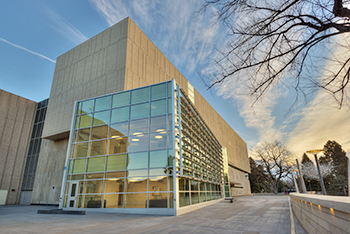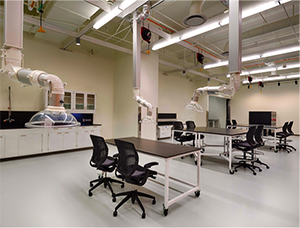Denver Museum Preserves Science with Sustainability
 DENVER — Ice Age fossils at the Denver Museum of Nature & Science (DMNS) are being preserved in a new wing that won’t break the bank in energy costs.
DENVER — Ice Age fossils at the Denver Museum of Nature & Science (DMNS) are being preserved in a new wing that won’t break the bank in energy costs.
The museum announced July 24 that the Morgridge Family Exploration Center, a 126,000-square-foot addition, has achieved LEED Platinum certification. DMNS partnered with Denver-based klipp-gkkworks and general contractor GH Phipps Construction, located in Greenwood Village, Colo., on the five-story addition that opened in February. The $60 million addition is the second museum project to receive LEED Gold or higher.
The space houses an atrium, labs, educational spaces, an exhibition gallery and the museum’s Discovery Zone. Below ground, the Rocky Mountain Science & Collections Center keeps the museum’s 1.4 million artifacts and specimens in an environmentally conditioned space.
“Achieving high-sustainability goals on museum facilities present unique design challenges,” said Maria Cole, an architect at klipp-gkkworks who worked on the museum’s last two projects, in a statement. “Climate control, galleries and collection storage, while saving energy, requires a sophisticated level of integration and communication amongst the team.”
Architects designed the museum’s expansion to operate with a 50 percent energy reduction below ASHRAE 90.1-2007. This equates to an operations savings of 62.2 percent in energy use.
 One way to achieve significant energy savings was the installation of an innovative open-loop water-source heat pump that uses Denver’s non-potable water system. Seven 30-ton heat pumps provide all of the building’s heating and cooling, as well as de-humidification during the summer, as they pump ground water to a heat exchanger inside the building and out again.
One way to achieve significant energy savings was the installation of an innovative open-loop water-source heat pump that uses Denver’s non-potable water system. Seven 30-ton heat pumps provide all of the building’s heating and cooling, as well as de-humidification during the summer, as they pump ground water to a heat exchanger inside the building and out again.
The new addition also has rooftop thermal panels that provide domestic hot water, and 200 kilowatts of solar panels to offset electricity usage. Low-flush toilets reduce 43 percent of potable water, and no potable water is used for irrigation.
Energy-efficient features also include triple-pane glazing in humidified areas, evaporative cooling, high-efficiency gearless elevators, and occupancy and photocell lighting controls.
During construction, crews were able to divert 62 percent of construction from landfills.
Renee Azerbegi, owner of Ambient Energy, the energy, daylight and LEED consultant on the project, remarked in a statement, “It was a pleasure to work with the museum’s team to help them achieve their extraordinary sustainability goals on this project – LEED Platinum and 50 percent energy savings. These notable sustainability benefits will be realized by the thousands of visitors each day.”
Construction funding for the new addition came from an $8 million gift from the Morgridge Family Foundation, the largest donation in the museum’s 109-year history. It’s the latest project in the museum’s “20/20” plan, which saw the completion of two projects in 2009: a new health science exhibition and a renovation of the Phipps Special Exhibits Gallery. The museum is also planning to include two new permanent exhibitions about earth science and anthropology.
“Earning LEED platinum certification allows the Museum to continue its goal of informal education about sustainable practices,” said Elaine Harkins, Denver Museum of Nature & Science facilities director, in a statement. “We will continue these efforts in our upcoming strategic plan.”
